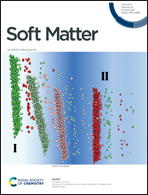Capillary forces drive buckling, plastic deformation, and break-up of 3D printed beams†
Abstract
Capillary forces acting at the interfaces of soft materials lead to deformations over the scale of the elastocapillary length. When surface stresses exceed a material's yield stress, a plastocapillary effect is expected to arise, resulting in yielding and plastic deformation. Here, we explore the interfacial instabilities of 3D-printed fluid and elastic beams embedded within viscoelastic fluids and elastic solid support materials. Interfacial instabilities are driven by the immiscibility between the paired phases or their solvents. We find that the stability of an embedded structure is predicted from the balance between the yield stress of the elastic solid, τy, the apparent interfacial tension between the materials, γ′, and the radius of the beam, r, such that τy > γ′/r. When the capillary forces are sufficiently large, we observe yielding and failure of the 3D printed beams. Furthermore, we observe new coiling and buckling instabilities emerging when elastic beams are embedded within viscous fluid support materials. The coiling behavior appear analogous to elastic rope coiling whereas the buckling instability follows the scaling behavior predicted from Euler–Bernoulli beam theory.



 Please wait while we load your content...
Please wait while we load your content...